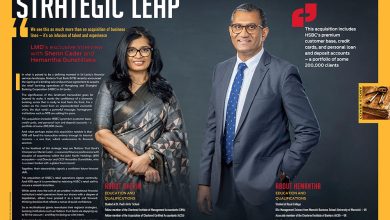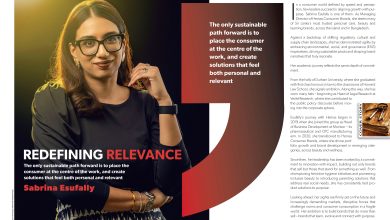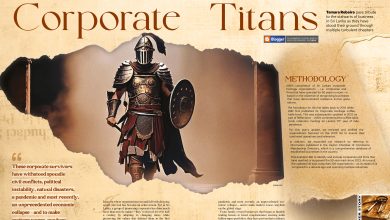COVER STORY

INTRODUCTION
Building resilience through love
Unveiling Sri Lanka’s Most Loved Brands for 2023
Following the financial implosion of the economy in April last year, all Sri Lankans have felt the pain. This in turn has influenced their purchasing habits across multiple categories. All consumer brands are under severe strain, and it is only those that have been able to rapidly adapt to the dramatically changed landscape and retain customers’ love that will survive.
These brands have certain distinct characteristics: they are familiar, and most often tried and tested brands that consumers have trusted – in many instances, for generations.
In addition, they offer the functional benefit of easing the economic burden through price, convenience, being longer-lasting and so on.
But this alone is not sufficient with brands that have succeeded being the ones demonstrating greater consumer empathy by doing things differently.
The top line results of our annual analysis of Sri Lanka’s most loved brands provide some overall trends. They include value for money brands showing a positive upward trend across categories, and consideration for high value products and premium brands dropping.
Meanwhile, in view of the ban on vehicle imports, consideration has declined in this segment – as well as for construction related brands as less people have been building houses during this period of high inflation.
And as household incomes have shrunk, nonessential category scores for the likes of biscuits have fallen.
It would seem that these trends are natural reactions to the economic pressures brought about by the extraordinary circumstances that consumers find themselves in. The strong relationships that many of the brands on our list have built in the past cushion them during such a crisis.
As consumer confidence is shaken, less loved brands tend to drop out of the basket of goods that consumers can afford to purchase. It is also likely that customers are less inclined to experiment and therefore, gaining confidence should be a key endeavour for those that are not in the top three of their respective categories.
Brands that have continued to invest in marketing would be well positioned to build loyalty. Given this scenario, it would seem obvious that brands should explore factors that could be used to build ‘love.’

THE WINNERS Certain categories are clearly much stronger and more competitive than others. These include banking, dairy, quick service restaurants, life insurance, pantry staples and women’s personal care, for example.
The Sri Lankan consumer market is relatively small and our historical findings suggest that there is little room for multiple brands to build sustainable business in each sector.
Categories with two strong brands – such as the biscuits, ice cream, telecommunications and ride hailing segments – enable the two main players to coexist profitably. Accordingly, a third player would be hard-pressed to gain market share and survive over the long term.
There have been few changes to the top 50 in our index, which supports the fact that the most loved are brands consumers turn to in times of crisis. While the brands in the top 10 have traded places, their positions are largely intact.
Both Dettol and Sunlight jointly head the index as the most loved brands this year. They have long registered high scores and often changed spots in the leadership race of Sri Lanka’s most loved brands.
ADAPT THE STRATEGY During difficult times, management is often compelled to abandon all brand investments. However, these are the very times when consumers want to feel reassured.
The methods that loved brands use to keep customers engaged have to radically change in these times of stress and hardship. With consumer aspirations on hold for the time being, they’re having to manage with an ever widening financial budget while striving to provide for the necessary nutritional and health requirements of their families, which is the priority.
In such circumstances, strategies should be led by being more socially responsible through authentic actions. As brands adapt to being true to their core, it highlights the importance of having a well-defined purpose, which can guide their actions during good times and bad.
Such is the power of building endurance to retain brand love.
By working off its tried and tested platform, a brand is more likely to impact loyal consumers and transform them into brand advocates who in turn can be converted to brand evangelists.
This core passionate group of consumers is the vital bedrock to building an enduring brand.
Love takes a long time to build. But once established, the built-up deposits of brand love help weather the storm… and it takes a lot to turn an advocate into a critic.
– Brand Finance

METHODOLOGY
The most loved brands list is compiled through an online survey covering 800 registered panel members in the Colombo and Gampaha Districts being managed and maintained by our research partner Breakthrough Business Intelligence. The research was carried out between November 2022 and January this year.
Respondents to our surveys are from the Colombo and Gampaha Districts as they account for a disproportionately large share of economic activity and consumer consumption in Sri Lanka.
Since we are evaluating the largest brands in the country, unless a brand has a significant presence in these regions, they will not be able to build critical mass. Furthermore, these regions are the trend-setters.
Our focus is on understanding changes in purchasing patterns over time to estimate the future potential of a brand.
Respondents to our surveys are exposed to and provide feedback on individual brands in separate categories. The three brands that emerge at the top of each category are featured in our table and as a matter of interest, we also provide a consolidated table with the 50 most loved brands with the highest scores across all sectors.
ELIGIBILITY FOR LISTING The criteria to be included in the list of brands for research purposes is based on our database and the historical data we have gathered over the last 10 years.
Brand Finance has a master list of brands in the main purchase categories operating in the country. These brands are reviewed annually by our team of analysts for their market presence during the year. This provides us with the categories and brands within them, which have established a strong presence across the country for a sustained period of time.
Since this is a multi-sector research study, the number of brands that represent each category can vary. For example, the banking sector is very large with many brands while the telecommunications industry has far fewer brands.
SCREENING AND SELECTION Respondents in the SEC A and B profiles within the 20-50 age group from Colombo and Gampaha were selected from an online panel of over 20,000 registered members.
They were further screened based on their purchases in a specific category. Only those who claimed to be aware of a brand rated it.
RESEARCH METHOD Respondents from the online panel rated brands on the level of trust associated with them and likelihood of considering a brand for purchase on a 10 point scale.
A total of 327 brands across 51 categories were taken into account in the research and each one was rated by 60 people (30 each from Colombo and Gampaha). In total, 800 respondents participated in the survey, and each person rated between 15 and 20 brands – depending on the size of the categories – through a structured online questionnaire.
Respondents rated brands based on individual sectors by benchmarking one brand against others within that sector. The scores were recorded on a 10 point scale on their level of trust association for individual brands and likelihood of considering a brand for purchase.
While a brand’s performance should be reviewed within the context of its sector, for the general interest of readers, we have also integrated the 50 brands that have the highest scores across all categories and featured them in a separate index.
As set out in our methodology, it should be noted that all the brands listed in the 50 loved index are not evaluated against each other if they are from different sectors.
DESTINATION BRANDS
The power of brand positioning
Ruchi Gunewardene cites national tourism destination brands to illustrate the process of brand positioning for products, services, corporates and even nations
The success of these brands is in their ability to evoke a distinct perception of them in our minds – and as such, they have not changed for decades. Incredible !ndia has been in use since its launch in 2002 and 100% Pure New Zealand since 1999.
Let’s explore brand positioning through destination brands as they evoke distinct responses from stakeholders. And this is what product, service and B2B brands should also aspire to build – i.e. powerful evocative brands that can withstand the test of time.
STRATEGIC APPROACH We do not know where the inspiration to develop these destination brands came from. It could well have risen from the mind of a creative individual (a right brain creation) or been diligently crafted from an in-depth study by a brand strategist (a left brain creation).
Whatever the approach, it required considerable skill and insights to distil the very essence of each country’s offering with a distinctive positioning expressed through a vivid brand promise.
The methodology must adopt a carefully engineered process involving a study of the category – including market research to discover current perceptions and trends, and uncover hidden consumer insights.
Success can be secured by following a logical approach that entails fact finding, research, consumer insights, hypothesis development, concept evaluation, and refining a brand’s definition and positioning.
Brand positioning enables a base or platform to be built on which wider marketing initiatives can be carried out.
DEFINING SUCCESS This platform builds synergy and thereby creates value as multiple stakeholders will leverage the brand across their individual platforms and needs. This highlights the importance of ensuring all stakeholders ‘buy in’ to the positioning.
The right brand positioning aligns product development, establishes service standards, motivates employees and develops relevant business processes. They can generate value additions and cost savings for companies.
BRAND STRENGTH A strong brand has absolute clarity on what it stands for. It leads to setting customer expectations and enables other stakeholders (suppliers, governments and so on) of the brand to take action.
Strong brands evoke positive responses through the imagery or association that they express from their proposition, thereby building memorability.
In this way, a strong brand evokes feelings and empathy with stakeholders, precisely because it is an axiom – a statement that’s established and accepted, and self-evidently true.
BRAND POSITIONING Sadly, Sri Lanka’s last branding attempt failed in all these aspects. It needed to be explained; and even then, it had significant
negative connotations.
Our economic bankruptcy can be perfectly captured through the ‘So Sri Lanka’ brand proposition! This highlights how inappropriate it was and its inability to fire up the imagination of stakeholders.
Here is what must be done as illustrated through a few winning brands.
First is differentiation, which can be measured through the degree of distinctiveness relative to the competitive set. The further the divergence from the norm, the more likely a brand will stand out. A key element of being different is being able to evoke distinctive imagery or associations.
Malaysia has taken the high ground through its brand positioning by encapsulating all the wonders and diversities of Asia into the country. This is clever as it simplifies travellers’ choices by evoking all the exotic associations to one country – Malaysia, Truly Asia.
The second factor is relevance to stakeholders. This is a measure of the significance of a brand’s features with stakeholders. When a brand takes a distinctive position, it naturally elicits beliefs. The more empathetic they are the better.
A country that has only a few attractions to offer travellers is the Maldives – namely, sun, sand and sea. To those who are merely seeking a quiet and leisurely beach holiday, the brand offers the perfect option through its highly relevant ‘sunny side of life.’
The final factor is the credibility of a brand’s offering. New Zealand’s brand promise of ‘100% Pure’ is rooted in a strong belief system that embraces sustainable practices and environmental protection. Its low population density makes for secluded travel destinations that are in pristine condition and perfectly capture the brand offer, making it highly credible.
In contrast, India embraces the diversity the country offers through one simple word: ‘incredible.’ It celebrates the chaos of the congested unplanned cities as well as the pristine beauty of the isolated Himalayas, and the historic splendour of the multitude of kingdoms, faiths, mysticism, sights, sounds and tastes that only India can offer.
MEASUREMENT AND FINE TUNING ‘It’s More Fun in the Philippines’ is a destination brand that’s interesting in that it was launched more recently.
Here’s a country where music is a passion, and present in every occasion and emotion, adding to the vibrant nightlife of its cities. The brand seems to have all the elements of longevity.
A successful brand needs active management and development. It is a diligent process that requires flashes of inspiration and creative expression but more importantly, a lot of hard-nosed digging to find that insight leading to a long-term and sustainable strategic brand positioning.
STRATEGIC MARKETING
Rethinking brand marketing
Ruchi Gunewardene laments the lack of strategic marketing thinking – which has been replaced by digital communications
Marketing and brand building in Sri Lanka is so intrinsically associated with the social media communications of most companies that heads of marketing positions are now filled with digital marketing expertise.
The strategic multi-skilled marketer is dead. As a result, many brands are losing sight of significant opportunities for growth.
With the multitude of tools and channels available for tactical communication in the digital age, marketing managers are expected to deliver growth through innovative content creation while deploying them across the spectrum of digital media channels.
To understand the potential beyond digital communication, we need to take a step back and review the strategic options available to build brands, gain market share and drive growth.
QUALITY AND POSITIONING Elon Musk, the founder of Tesla Motors, banished any form of advertising investment for the Tesla S, Tesla X and Tesla 3. To him, advertising was a waste as it was contrived and inauthentic.
Instead, he invested heavily in his product offering… as he insisted it would speak for itself.
To get out of the communication trap, Sri Lanka’s marketers must stop relying on large marketing budgets and instead, explore alternative cost-effective options for growth. This must begin with the product itself and explore product improvements from a customer centric mindset.
The marketing team should be intrinsically involved in innovation and enhancement as it is the custodian of the customer within the company.
Deep introspection is also required to identify stimuli and barriers to purchasing a product or service across
myriad influencing factors – such as emotional triggers and aspirations, price sensitivity, distribution and availability, points of differentiation, distinctive design, service delivery standards and related employee training among many others – the majority of which are beyond the sphere of digital marketing.
The launching pad for strategic marketing is effective research and data driven segmentation of the entire market, providing the marketing manager with a bird’s-eye view of existing and potential customers.
This should result in careful long-term positioning of the brand relative to the competition and an overall strategic marketing plan.
EXISTING CUSTOMERS Most marketing departments invest huge sums of money in communications with no distinction between current and lapsed customers, and non-users, on the premise that the messaging will be picked up by the relevant group.
A lack of focus across various customer segments (that have entirely different mindsets) undermines the loyal customer base, which is the bread and butter of the company. Herein lies the low hanging fruit – meaning, to engage with them to make them even more loyal users, and also spread positive messages about the brand to their friends and family. The opportunity is to convert loyal customers into brand advocates.
Word of mouth is a powerful tool that was extensively leveraged by Tesla in its early global promotions. The company formed Tesla clubs, which comprised ardent fans who were offered points for redemption (to be used when they bought their next car) based on the number of friends they recommended to buy a vehicle from the company. A few were so successful that they were able to get a free Tesla for themselves!
Besides loyalty programmes and membership clubs, other strategies such as cross selling or providing special offers before they become available to the broader customer base are options to explore. This provides a positive signal and acknowledges loyal customers as being special.
Such initiatives demonstrate that the brand truly cares, thereby building closer relationships and customer advocacy. The ultimate aim is to establish a core group of brand evangelists.
Relevant product enhancements, careful long-term positioning and building passionate customers should be priorities.
EXPANDING THE BASE Educational content can help expand the customer base – especially for new products – because it answers customer queries, induces trials and provides a physical or virtual handholding service for non-users.

Providing educational content may also increase customer satisfaction because it may answer questions they have and teach them how to derive better results. This may also include free sampling, experiential videos, infographics, blogs, webinars, workshops and so on.
Additionally, physical interaction with customers will result in further learning, leading to product modifications and improvements based on feedback.
When Tesla was launched, stores were opened in shopping malls and retail centres while cutting out dealers, thereby providing direct access to customers who were able to be educated and experience the products firsthand. Essentially, it was an innovative way of sampling in the world of car sales.
BUILDING PARTNERSHIPS This is an often overlooked area but it could result in synergy between brands. Mutual goals need to be established as well as co-hosting or co-branding where relevant.
Uber’s association with Spotify is a great example of this. The Uber customer is able to listen to music through Spotify while travelling in a vehicle. While music makes for a more pleasant ride experience, Spotify expands its customer base.
Another great example is the partnership between Coca-Cola and The Jack Russell Company, which introduced the famous yo-yo promotion. Through this association, Jack Russell sold yo-yos through Coca-Cola’s extensive distribution system. Meanwhile Coca-Cola sold more products because of the promotion.
The value of such third party endorsements (either direct or indirect) should not be discounted as it provides an independent seal of approval for a brand. Developing such credible independent partnerships can only strengthen a brand.
INTERNAL MARKETING A company must build a brand on the inside for the benefit of customers outside.
There is usually a substantial waste of marketing budgets as investments are made in communicating with customers but bypass employees. Because many departments do not know what’s happening or expected of them when customers call directly, the brand is unable to deliver what has been promised.
Therefore, aligning the brand promise with service delivery, training and monitoring is vital, along with a strong internal marketing process that constantly updates employees across departments. This adds to the synergy of external marketing programmes.
RETHINKING MARKETING Communication is the heroin that drives most marketing initiatives these days. Weaning away from this will force a more critical review of what else could be done with the adoption of an innovative and more impactful approach to marketing.
To leverage this power, companies need to appreciate the value a strategic marketer can bring to the business.













